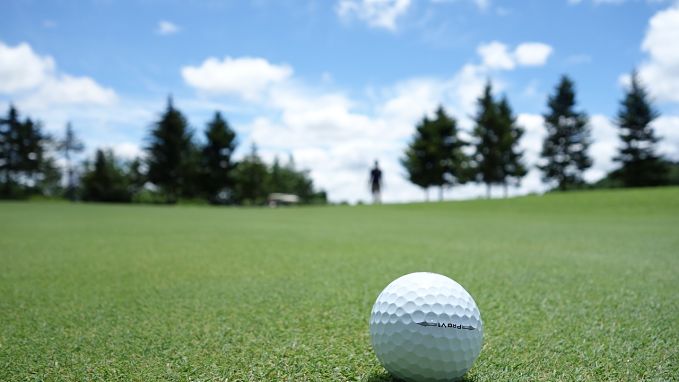 Knowing how to spin a golf ball and control it is important if you want to take your short game to the next level. These tips will help you master the art of spin.
Knowing how to spin a golf ball and control it is important if you want to take your short game to the next level. These tips will help you master the art of spin.
If you really want to get good at golf you need work on mastering your shots hit from one hundred yards and in. Plain and simple, the short game is what will win or lose a match.
Unfortunately, it always seems like no two short game shots are the same, each one requiring a unique trajectory and path to the hole. But for all shots hit from within one hundred yards, there is one great commonality: the need to put backspin on the ball.
If you’ve ever tuned into one of the pro tours on television you are well-aware of what backspin is: a shot lands on the green and instead of rolling forward it stops on a dime and spins back to the hole. Unfortunately for most amateur’s spin like that will be difficult to get but that does not mean that generating backspin is impossible.
If you want to enjoy short game shots that stop on a dime, read on for a guide to generating more backspin on the ball.
How to put backspin on a golf ball
It starts with your equipment
Before you can start generating backspin you need to make sure that the equipment you are using is fit for the job. The first thing you will need to take a look at is your wedges.
The grooves on your wedge’s face are going to determine how much spin the club is able to produce. Nice wide sharp grooves are going to maximize your potential for generating back spin on the ball. The older the wedge gets, however, the duller the grooves become.
To test the sharpness of your grooves you will simply want to run your finger over the clubface. You will be able to tell just by feeling it whether or not age has dulled the grooves of your club. If the grooves do not feel nice and sharp you are most likely going to need to purchase a new wedge to enjoy the best possible results.
It is also important that you regularly clean the face of your clubs to ensure that your grooves are in good working order. For your wedges, soaking the clubhead in warm water, then running the pointy end of a tee through the grooves should do the trick.
After you have taken the time to make sure your wedge is fit for the task of generating spin, your next job will be to consider your choice of golf ball.
With all the options for golf balls out there it can be very difficult to choose the one best for your game. Many shops offer golf ball fittings where a professional will work with you as you hit shots to determine the ball that will give you the best combination of accuracy, distance, and backspin.
Ball fittings are great for those with the time and money but if that sounds like more of a commitment than you would care to make it is still possible to choose a ball that will maximize your spin potential.
Most golf ball covers are made with either ionomer or urethane. Ionomer is a plastic while urethane has softer rubber components to it. Both balls will look identical but where they differ is in feel and performance.
Ionomer balls are actually designed not to spin very much. The less a ball spins the harder it is to produce hooks and slices. Ionomer cover balls are going to fly longer and straighter which makes them a top choice for players who are still developing their skills.
The urethane cover is without question your best bet for maximum spin. Fair warning however, if you aren’t an experienced player you may struggle a little bit with a urethane cover, or at the very least you won’t get your money’s worth out of it.
While the urethane ball is engineered with spin in mind, that also includes side spin. If you are struggling off the tee already you may want to reconsider the urethane ball as the increased susceptibility to side spin may only worsen the problem.
If you fall into that category but still want to work on producing more spin, you are not entirely without hope. An ionomer ball that advertises it is of a three-piece design will spin a little bit more than the standard ionomer ball. You won’t get quite the same spin capacity that you experience with the urethane ball but it will be enough to help your short game, and you will probably also save some money, which of course is a big plus.
Once you have determined which ball is right for you, you will be ready to start working on your technique.
Set up
Like most things in golf, the approach for generating good spin starts with your stance. To spin a ball backwards, you will need to adopt a very steep angle of attack. In order to get that without making any significant changes in your swing, set up with the ball toward your back foot.
The rest of your set up is mostly going to remain the same. In addition to playing the ball on your back foot you may also want to let your weight favor the front foot. While not essential, it will further help you get the steep angle of attack that is necessary to produce spin.
The swing
The goal with the swing here is to produce a lot of club head speed. That doesn’t mean swing harder, it means swing better. If your tempo could use a helping hand, spend some time working on that to ensure that the momentum of your clubhead reaches its maximum velocity right at the moment of impact – which will help get the ball in the air quickly and help produce more spin.
A good easy way to practice this is to come up with a three-word phrase on your back swing (Jack Nicklaus used “low and slow”) and then a one-word phrase on the down swing. We do this to ensure that the backswing takes three times as long as the down swing, which results in more power getting applied to the impact.
You will also need to make sure you are contacting the ball first, and then the turf. Fortunately, by playing the ball off your back foot you will have a relatively easy time accomplishing this.
If you are struggling with contacting the ball first, a good drill you can use is to place a tee several inches behind the ball, and make it your goal to avoid contacting the tee.
Assuming you have the right equipment at your disposal, this set up and swing will help you start getting more spin out of the ball.
Other things to consider
While a good setup and capable equipment are both great ways to get spin, there are also a number of variables to consider as you try this new technique out on the course.

Your lie
When it comes to spinning the ball, what sort of lie you have is going to make all the difference. For best results, you should hope for a clean fairway lie that offers you a nice, even stance. Getting a lot of spin from the rough is almost impossible even for the game’s best.
Slope
What sort of spin you are able to get will also depend largely on the slope of the greens. If you are able to land the ball on a downward slope you can count on getting a lot more backspin then you will find from a flatter surface.
Club loft
The lower the loft of the club, the less likely it is you will be able to produce spin. Without question, you are going to generate the most spin from your wedges, but with some practice, you may also eventually be able to spin the ball a little bit with your low irons.
The wind
If you are playing a shot downwind, you probably aren’t going to be able to get a lot of spin. Playing a shot against the wind, however, is going to be beneficial in this case.
The wind will help get your ball up in the air for that nice soft landing that is required to enjoy back spin. Of course, there are drawbacks: when playing into the wind, proper club selection (especially when it comes to wedges) can be difficult to determine.
Course conditions
Dry or overly firm greens are going to be difficult to spin the ball on. While adopting the techniques illustrated in this guide will help keep your ball from rolling off the green, you shouldn’t expect to zip the ball back.
Conclusion
Your journey towards increased backspin might not be quick, or easy but if you take your golf game seriously it will definitely be worth the efforts. Knowing how to spin a golf ball with control will help you get it closer to the hole, and ultimately lower your scores.
As you go through the process just try and be patient and have fun. That’s the point of golf anyway, and at the end of the day if you put the work in, you will impress your friends, and get that handicap down a bit.
Good luck on the course!

